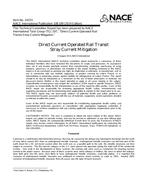NACE 10B189
Click here to purchase
Corrosion is a well-known electrochemical process that may be caused by the pickup and subsequent discharge into the earth of stray direct current (DC) from an underground metallic structure. Underground metallic structures can become part of the earth return for a DC rail transit system when the earth acts as a parallel path to the rails; the metallic structures are then subject to corrosion. The first electric railways in the U.S. were placed into operation during the latter half of the nineteenth century. Very early in the development of these systems, the running rails were used as conductors for returning traction current to the power source. Because most of these systems were street railways or trolleys, the areas in which the railways were built were also the areas most likely to have underground metallic structures, especially piping. It is reported that corrosion of underground metallic structures was attributed to streetcar return currents as early as 1891. Around 1900, corrosion of underground metallic structures from all causes was the topic of much research.
All DC traction systems using rail return of traction current have a level of leakage that is dependent on both design and operating factors affecting the efficiency of the rail return path. This current leakage is known as stray current. Stray current can create safety hazards and have serious effects on utility structures and the community at large.
The purpose of this report is to present information on rail transit stray current as it concerns transit and utility engineers. The report is not a detailed text or “cookbook,” but rather a report that gives guidance on the mitigation of transit system stray current.
Product Details
- Published:
- 08/01/2014
- Number of Pages:
- 20
- File Size:
- 1 file , 560 KB
